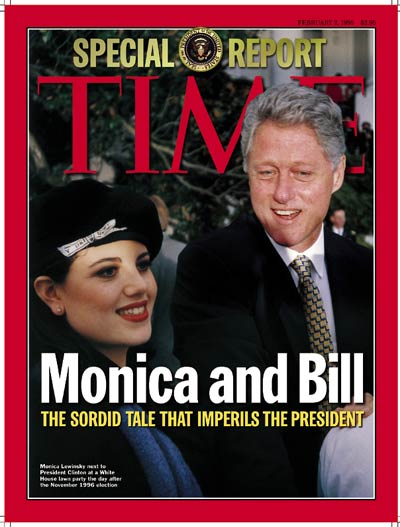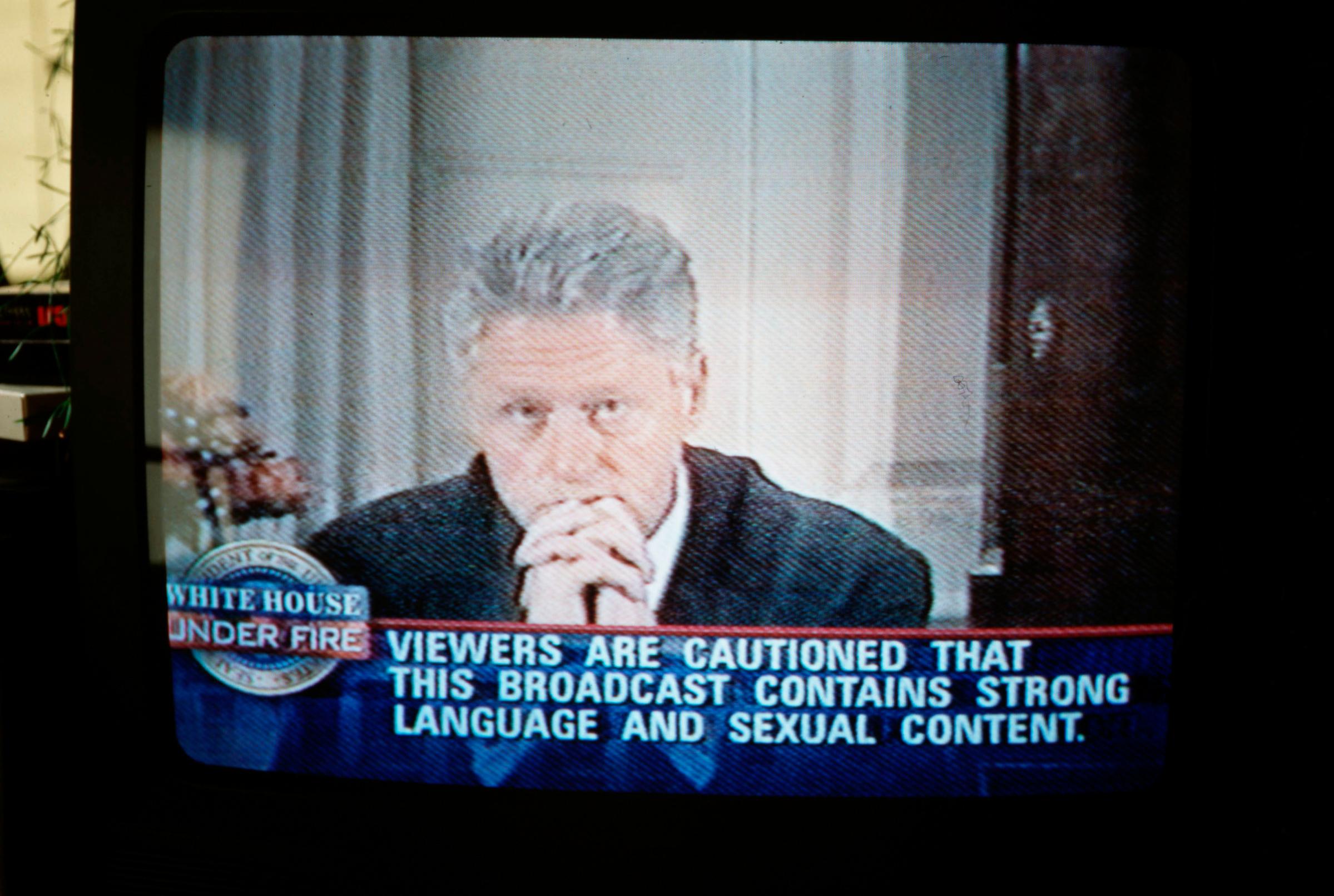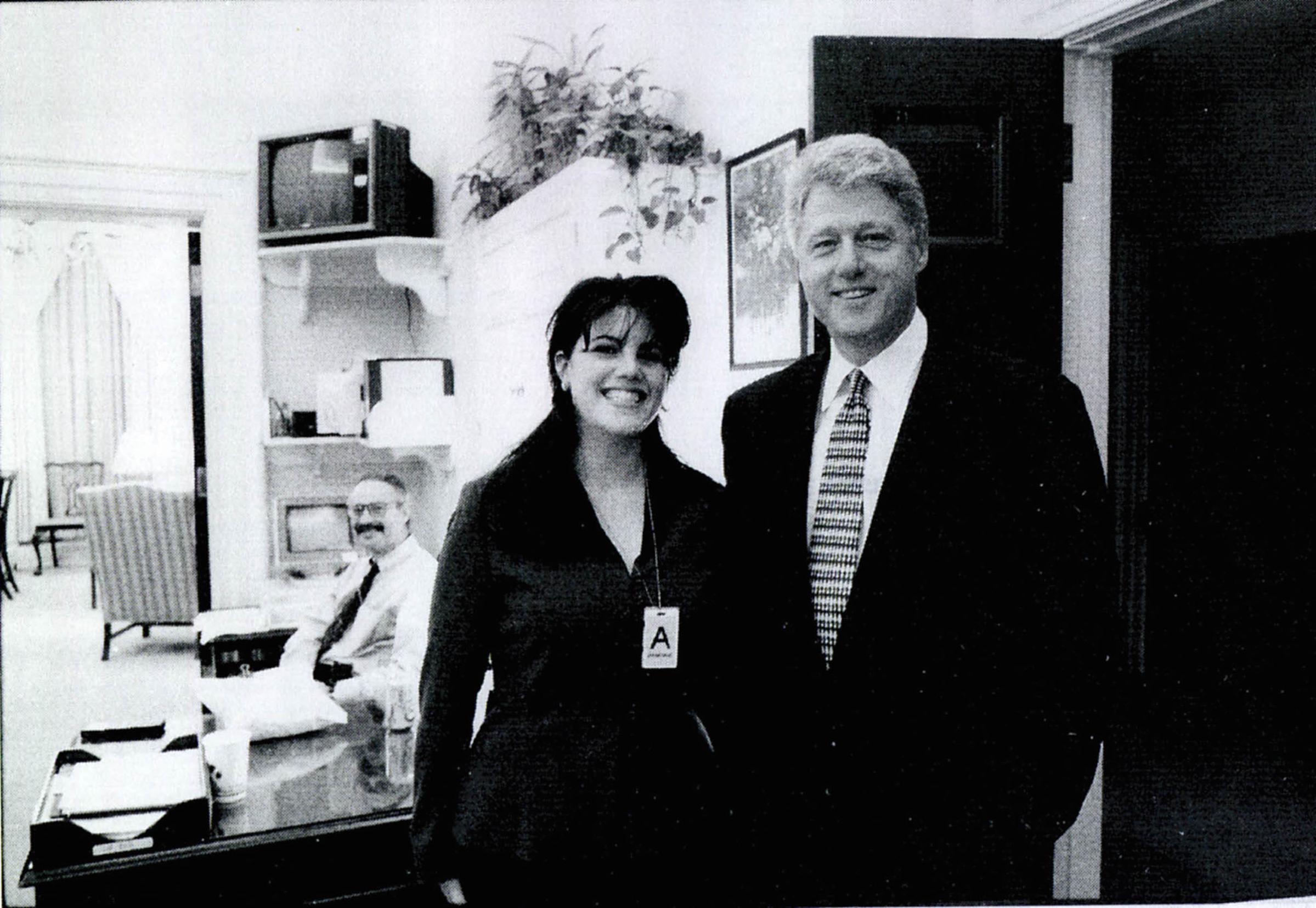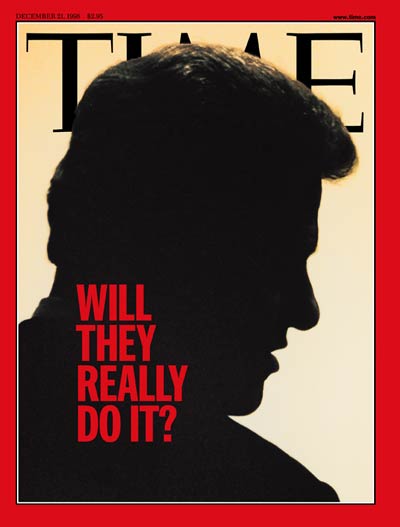In June 1995, Monica Lewinsky’s move to Washington, D.C., was unremarkable. She was a 21-year-old recent college grad with an unpaid internship in the office of President Bill Clinton’s Chief of Staff Leon Panetta, landed with the help of a family connection. But, as the nation later learned, things happened quickly from that point, as it was that year that she began a relationship with the President that would last about two years and lead to an epoch-shaping scandal.
The relationship between Lewinsky and President Clinton came to light 20 years ago, and the fallout would dominate 1998’s news.
And even 20 years later, the scandal continues to serve as a reference point for American politics, from Lewinsky’s tweets — for example, her quip that “blaming the intern is so 1990s” after Sen. Marco Rubio called out a journalism intern over a story — to President Trump’s addition of Clinton impeachment lawyer Emmet Flood to his own legal team. Below is a glimpse, with two decades of hindsight, at how that historic year unfolded.
January
Jan. 7: Lewinsky signed an affidavit stating that she never had a sexual relationship with Clinton, at the request of attorneys representing Paula Jones, who had accused Clinton of sexual harassment in 1994. Jones claimed she suffered emotional damage after Clinton exposed himself to her in an Arkansas hotel room in May of 1991. A conservative legal group that had volunteered to fund her lawsuit had gotten an anonymous tip about Lewinsky, so Jones’ lawyers subpoenaed Lewinsky in hopes of arguing that Clinton displayed a pattern of workplace harassment.
Jan. 12: Independent Counsel Kenneth Starr — who had been investigating Whitewater, a scandal-plagued Arkansas real-estate venture with which the Clintons had been involved — receives more than 20 hours of tapes of phone conversations that seem to contradict the affidavit. The tapes come from Linda Tripp, who had become close friends with Lewinsky in 1996 while the two worked in the Pentagon’s public affairs office, and to whom Lewinsky had confided about President Clinton.
Jan. 13: At the Ritz-Carlton Hotel in Pentagon City, Va., Lewinsky dishes more about the relationship to Tripp, who’s been secretly wired by FBI agents, per Starr’s orders.
Jan. 16: A court of appeals panel gives Starr the green light to add the Clinton-Lewinsky allegations to his portfolio to see if she lied under oath. Tripp tells Jones’ lawyers about Lewinsky’s affair with the President.
Jan. 17: Matt Drudge’s Drudge Report reports that Newsweek had been tipped off about President Clinton’s affair with a White House intern named Monica Lewinsky, but had yet to run a story about it. On the same day, Clinton denies the affair in a deposition in the Jones suit — the deposition that earns him the dubious distinction of being the first sitting U.S. President to give testimony in a civil case in which he’s the defendant.
Jan. 21: Drudge publishes allegations that Lewinsky had kept a “garment with Clinton’s dried semen.” Mainstream news outlets pick up his report over the course of the week. FBI tests, however, find no DNA evidence on Lewinsky’s clothes.
Jan. 26: President Clinton denies the report on television, uttering what would become one of the most memorable lines of the scandal: “I did not have sexual relations with that woman, Miss Lewinsky.”
![William J. Clinton [& Wife];Monica Lewinsky [Misc.] William J. Clinton [& Wife];Monica Lewinsky [Misc.]](https://api.time.com/wp-content/uploads/2018/02/clinton-denial.jpeg?quality=75&w=2400)
Jan. 27: On The TODAY Show, First Lady Hillary Clinton dismissed the allegations as a “vast right-wing conspiracy that has been conspiring against my husband since the day he announced [his run] for president.” That same day, Andy Bleiler, who had had a five-year affair with Lewinsky, goes public with the claim that she had told him she had oral sex with the president and joked to his wife that she would invest in “presidential kneepads.”
Jan. 29: U.S. District Court Judge Susan Webber Wright rules that the Lewinsky scandal can’t be incorporated into the Jones suit, arguing the matter is “not essential to the core issues in this case.”
February

Feb. 2: “When it comes to women, Clinton has had a lifetime of enablers—not just the friends who egged him on but also the ones who helped him sidestep accusations,” TIME notes in a special report on the scandal. “If it takes a village to raise a child, maybe it takes a circle of complicit friends to help a grown man go on acting like a teenager.”
Feb. 6: Clinton says in a press conference that he won’t resign.
Feb. 10: Lewinsky’s mother, Marcia Lewis, appears before a grand jury. Suspected of encouraging Lewinsky to lie to Jones’s lawyers and accused of hiding the stained dress, she was grilled by Starr’s team for nearly three days until she became too overwhelmed. “Starr granted Lewis full immunity in exchange for delivery of the suspect dress,” TIME reported.
Feb. 11: Retired Secret Service agent Lewis C. Fox became “the first person to publicly say that he saw the president and Lewinsky alone together,” the Washington Post reports.
March
Mar. 15: Kathleen Willey, a campaigner for and donor to Clinton’s in 1992 presidential campaign, tells 60 Minutes that Clinton groped her in the Oval Office in 1993. Over the next two weeks, a flight attendant and a former Miss America also claim they were groped by Clinton.
Mar. 21: President Clinton moves to invoke executive privilege to prevent top aides from testifying about private conversations that they had with him.
April
Apr. 1: A judge dismisses Paula Jones’ sexual harassment suit over a lack of evidence. Paula Jones will file an appeal at the end of July.
Apr. 29: D.C. Circuit Court judge Norma Holloway Johnson, who would preside over the grand jury investigation into the affair, rejects Lewinsky’s lawyer’s argument that she has an immunity agreement with Starr. (Immunity had been offered, but the deal was never completed.)
Apr. 30: “I really believe it’s important for me not to say any more about this,” Clinton says at a press conference in response to a question about whether he thought the American public should care about what President does in his private life. “I think that I’m in some ways the last person who needs to be having a national conversation about this.”
May
May 5: Lewinsky’s lawyer William Ginsburg tells reporters he agreed to let Vanity Fair send celebrity photographer Herb Ritts photograph his client in Malibu, Calif., because Starr has imprisoned her “libido.” He said he hoped that the shoot would help her “feel good about herself.”
May 22: Judge Holloway says Secret Service agents must testify before the grand jury in the Lewinsky case, rejecting an argument that they have “protective function privilege.”
June
Jun. 2: Clinton’s lawyers stop pursuing his claim of executive privilege, and the media argues that’s because he didn’t want to be known as the first president since Richard M. Nixon to take an executive privilege claim to the Supreme Court. Also this day, Lewinsky fires Ginsburg and hires new lawyers, Jacob Stein and Plato Cacheris, who met secretly with Starr to reiterate that they want to get things done quietly, but without their client having to plead guilty to anything.
Week of Jun. 10: The July issue of Vanity Fair appears on newsstands, featuring those glamour shots of Lewinsky posing like Marilyn Monroe—a look that does not go over well in the court of public opinion.
July
July 17: Subpoenaed Secret Service agents report to the grand jury, and Clinton himself is served with a subpoena that compels him to testify. Over the course of the following week, Clinton’s personal secretary Betty Currie and lead Secret Service agent Larry Cockell would also testify.
July 27: Lewinsky meets with Starr’s prosecutors in New York City. The next day, they announce an immunity deal for her.
July 29: Clinton agrees to testify before the grand jury voluntarily.
August
Aug. 3: A blood sample is taken from Clinton for DNA testing against stains from the blue dress taken from Lewinsky. The story becomes public news on Aug. 19.
Aug. 6: Lewinsky begins to testify before the grand jury, having already spent days in interviews.
Aug. 17: Clinton testifies to the grand jury for more than four hours on closed circuit television. He admits to “inappropriate intimate contact” but also says that he had given accurate evidence in January, arguing that, “It depends on what the meaning of the word ‘is’ is.” That evening, he speaks to the nation in a televised address, admitting for the first time that he had a relationship with Lewinsky “Indeed, I did have a relationship with Miss Lewinsky that was not appropriate. In fact, it was wrong. It constituted a critical lapse in judgment and a personal failure on my part for which I am solely and completely responsible,” he says.

September
Sept. 9: Congress receives two copies of Starr’s 445-page report on the investigation, and supporting evidence, which take up 36 boxes. In the report, he details the findings of his four-year, $52 million investigation, only mentioning the Whitewater land deal a handful of times. The report cites 11 impeachable offenses.
Sept. 11: Congress releases the Starr Report to the public. Over the following days, video of Clinton’s testimony, as well as transcripts of Lewinsky and Tripp are released.
Sept. 14: A CNN/USA Today/Gallup poll finds that Clinton’s approval is rating up, at 64%. Meanwhile, 31% think he should be impeached and 36% say he should resign.

October
Oct. 2: Transcripts of Lewinsky and Tripp’s taped telephone conversations are released.
Oct. 5: The House judiciary committee votes along party lines to recommend an impeachment inquiry. In such a situation, the House decides whether to charge the president with impeachment, and what charges should be brought, then the Senate acts as a jury and decides whether to acquit or convict. (A two-thirds majority in the Senate is required to remove the president from office.)
Oct. 8: The House of Representatives votes to begin an open-ended impeachment inquiry, allowing the House Judiciary Committee to draw up charges based on Starr’s report allegations. Thirty-one Democrats vote in favor of opening the inquiry.
November
Nov. 3: In 1998’s midterm elections, Democrats score unexpected gains, adding five seats in the House while the ratio of Republicans to Democrats remains the same in the Senate. (In a typical off-year election the president’s party loses seats.) Surveys of voters showed that a majority didn’t want congress to hold impeachment hearings or want Clinton, whose popularity remained high, to resign.
Nov. 5: The House Judiciary Committee asks Clinton 81 written questions about the independent counsel’s report. Questions ranged from “Do you admit or deny that you are the chief law-enforcement officer of the United States of America?” to a precise accounting of whether he gave particular gifts to Lewinsky.
Nov. 13: Clinton settles the appealed sexual harassment suit with Paula Jones out of court, paying her $850,000 and admitting nothing.
December
Dec. 11: The House Judiciary committee votes to recommend impeachment. They approve two articles of impeachment pertaining to perjury — one for lying to a grand jury and another for his testimony in response to questions about his relationship with Lewinsky — and one about obstruction of justice.
Dec. 12: Clinton says he won’t resign, and again denies lying under oath. That same day, the House Judiciary Committee approves a fourth article of impeachment, alleging falsehoods in his answers to the 81 questions the committee had asked. They also reject a resolution to censure his “reprehensible conduct,” supported by Democrats; such a measure would have allowed Congress to express disapproval without resorting to impeachment.
Dec. 16: Clinton orders air strikes against Iraq after Saddam Hussein refuses to allow U.N. weapons inspectors to enter the country, delaying the House impeachment vote.

Dec. 19: The House of Representatives votes to impeach President Clinton on two of the four articles of impeachment (the charge of perjury in his Aug. 17 federal grand jury testimony, and charge that he “prevented, obstructed and impeded the administration of justice.”) Clinton vows to remain in office until “the last hour of the last day of my term.” A Gallup poll finds record-high approval of how he handles his job as president.
As the year came to a close, TIME noted that 1998 had taken a toll on Washington: “ All around the city there was a feeling that brutal, lasting damage had been done to an already threadbare culture of political accommodation, that impeachment would be not the end of something but the beginning. And that it would be something bad.”
After 1998
Jan. 7, 1999: The Senate begins its trial of President Clinton. In an impeachment trial, the Supreme Court’s Chief Justice presides and the 100 Senators serve as jurors.
Jan. 19, 1999: Clinton delivers his State of the Union address, which doesn’t mention the investigation or impeachment at all.
Jan. 27, 1999: The Senate rejects a motion to dismiss impeachment charges.
Feb. 8, 1999: Closing arguments are delivered from the two sides. The Senate begins private deliberations the following day.
Feb. 12, 1999: The Senate finishes the impeachment trial, acquitting Clinton on both charges. The votes come in at 55-45 on perjury and 50-50 on obstruction of justice. Republicans block a Democratic move to censure President Clinton. By TIME’s count, 2,345 minutes of the CBS, NBC and ABC evening newscasts between Jan. 22, 1998, and Feb. 12, 1999, had been devoted to the scandal.
More Must-Reads from TIME
- Cybersecurity Experts Are Sounding the Alarm on DOGE
- Meet the 2025 Women of the Year
- The Harsh Truth About Disability Inclusion
- Why Do More Young Adults Have Cancer?
- Colman Domingo Leads With Radical Love
- How to Get Better at Doing Things Alone
- Michelle Zauner Stares Down the Darkness
Write to Olivia B. Waxman at olivia.waxman@time.com